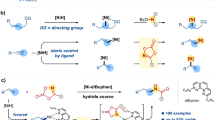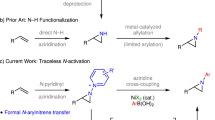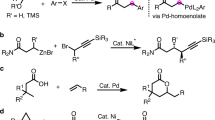Abstract
Nitriles are found in many bioactive compounds, and are among the most versatile functional groups in organic chemistry. Despite many notable recent advances, however, there are no approaches that may be used for the preparation of di- or tri-substituted alkenyl nitriles. Related approaches that are broad in scope and can deliver the desired products in high stereoisomeric purity are especially scarce. Here, we describe the development of several efficient catalytic cross-metathesis strategies, which provide direct access to a considerable range of Z- or E-di-substituted cyano-substituted alkenes or their corresponding tri-substituted variants. Depending on the reaction type, a molybdenum-based monoaryloxide pyrrolide or chloride (MAC) complex may be the optimal choice. The utility of the approach, enhanced by an easy to apply protocol for utilization of substrates bearing an alcohol or a carboxylic acid moiety, is highlighted in the context of applications to the synthesis of biologically active compounds.
This is a preview of subscription content, access via your institution
Access options
Access Nature and 54 other Nature Portfolio journals
Get Nature+, our best-value online-access subscription
$29.99 / 30 days
cancel any time
Subscribe to this journal
Receive 12 print issues and online access
$259.00 per year
only $21.58 per issue
Buy this article
- Purchase on Springer Link
- Instant access to full article PDF
Prices may be subject to local taxes which are calculated during checkout






Similar content being viewed by others
Data availability
X-ray crystallographic data for compound 9a, are freely available from the Cambridge Crystallographic Data Centre (CCDC 1861573). Copies of the data can be obtained free of charge via https://www.ccdc.cam.ac.uk/structures/. All other data in support of the findings of this study are available within the Article and its Supplementary Information or from the corresponding author upon reasonable request.
References
Fleming, F. F., Yao, L., Ravikumar, P. C., Funk, L. & Shook, B. C. Nitrile-containing pharmaceuticals: efficacious roles of the nitrile pharmacophore. J. Med. Chem. 53, 7902–7917 (2010).
Sugura, J. L., Martin, N. & Hanack, M. Oligo-2,6-naphthylenevinylenes—new building blocks for the preparation of photoluminescent polymeric materials. Eur. J. Org. Chem. 1999, 643–651 (1999).
Allgäuer, D. S. et al. Quantification and theoretical analysis of the electrophilicities of Michael acceptors. J. Am. Chem. Soc. 139, 13318–13329 (2017).
Serafimova, I. M. et al. Reversible targeting of nanocatalytic cysteines with chemically tuned electrophiles. Nat. Chem. Biol. 8, 471–476 (2012).
Lee, D., Kim, D. & Yun, J. Highly enantioselective conjugate reduction of β,β-disubstituted α,β-unsaturated nitriles. Angew. Chem. Int. Ed. 45, 2785–2787 (2006).
Yan, Q., Kong, D., Li, M., Hou, G. & Zi, G. Highly efficient Rh-catalyzed asymmetric hydrogenation of α,β-unsaturated nitriles. J. Am. Chem. Soc. 137, 10177–10181 (2015).
Müller, M.-A. & Pfaltz, A. Asymmetric hydrogenation of α,β-unsaturated nitriles with base-activated iridium N,P ligand complexes. Angew. Chem. Int. Ed. 53, 8668–8671 (2014).
Lee, J.-E. & Yun, J. Catalytic asymmetric boration of acyclic α,β-unsaturated esters and nitriles. Angew. Chem. Int. Ed. 47, 145–147 (2008).
Deutsch, H. M. et al. Synthesis and pharmacology of site-specific cocaine abuse treatment agents: 2-(aminomethyl)-3-phenylbicyclo[2.2.2]- and -[2.2.1]alkane dopamine uptake inhibitors. J. Med. Chem. 42, 882–895 (1999).
Janssen, P. A. et al. In search of a novel anti-HIV drug: multidisciplinary coordination in the discovery of 4-[[4-[[4-[(1E)-2-cyanoethyenyl]-2,6-dimethylphenyl]amino]-2-pyrimidinyl]amino]benzonitrile (R278474, Rilpivirine). J. Med. Chem. 48, 1901–1909 (2005).
Castellino, S. et al. Central nervous system disposition and metabolism of fosdevirine (GSK2248761), a non-nucleoside reverse transcriptase inhibitor: an LC-MS and matrix-assisted laser desorption/ionization imaging MS investigation into central nervous system toxicity. Chem. Res. Toxicol. 26, 241–251 (2013).
Zhang, L.-H. et al. The synthetic compound CC-5079 is a potent inhibitor of tubulin polymerization and tumor necrosis factor-a production with antitumor activity. Cancer Res. 66, 951–959 (2006).
Ruchelman, A. L. et al. 1,1-Diarylalkenes as anticancer agents: dual inhibitors of tubulin polymerization and phosphodiesterase 4. Bioorg. Med. Chem. 19, 6356–6374 (2011).
Searle, P. A., Molinski, T. F., Brzezinski, L. J. & Leahy, J. W. Absolute configuration of phorboxazoles A and B from the marine sponge Phorbas sp. 1. Macrolide and hemiketal rings. J. Am. Chem. Soc. 118, 9422–9423 (1996).
Dalisay, D. S. & Molinski, T. F. Structure elucidation at the nanomole scale. 2. Hemi-phorboxazole A from Phorbas sp. Org. Lett. 11, 1967–1970 (2009).
Doyle, M. P. et al. Lewis acid promoted reactions of diazocarbonyl compounds. 3. Synthesis of oxazoles from nitriles through intermediate β-imidatoalkenediazonium salts. J. Org. Chem. 45, 3657–3664 (1980).
Vedejs, E., Piotrowski, D. W. & Tucci, F. C. Oxazolium-derived azomethine ylides. External oxazole activation and internal dipole trapping in the synthesis of aziridinomitosene. J. Org. Chem. 65, 5498–5505 (2000).
Suganuma, M. et al. Calyculin A, an inhibitor of protein phosphatases, a potent tumor promoter on CD-1 mouse skin. Cancer Res. 50, 3521–3525 (1990).
Jang, H., Romiti, F., Torker, S. & Hoveyda, A. H. Catalytic diastereo- and enantioselective addition of versatile allyl groups to N–H ketimines. Nat. Chem. 9, 1269–1275 (2017).
Zhang, Z. & Liebeskind, L. S. Palladium-catalyzed, copper(i)-mediated coupling of boronic acids and benzylthiocyanate. A cyanide-free cyanation of boronic acids. Org. Lett. 8, 4331–4333 (2006).
Powell, K. J., Han, L.-C., Sharma, P. & Moses, J. E. Chemoselective palladium-catalyzed cyanation of alkenyl halides. Org. Lett. 16, 2158–2161 (2014).
Nakao, Y., Yada, A., Ebata, S. & Hiyama, T. A dramatic effect of Lewis-acid catalysts on nickel-catalyzed carbocyanation of alkynes. J. Am. Chem. Soc. 129, 2428–2429 (2007).
Zhang, X., Xie, X. & Liu, Y. Nickel-catalyzed highly regioselective hydrocyanation of terminal alkynes with Zn(CN)2 using water as the hydrogen source. J. Am. Chem. Soc. 140, 7385–7389 (2018).
Qin, C. & Jiao, N. Iron-facilitated direct oxidative C–H transformation of allylarenes or alkenes to alkenyl nitriles. J. Am. Chem. Soc. 132, 15893–15895 (2010).
Murai, M., Hatano, R., Kitabata, S. & Ohe, K. Gallium (iii)-catalysed bromocyanation of alkynes: regio- and stereoselective synthesis of β-bromo-α,β-unsaturated nitriles. Chem. Commun. 47, 2375–2377 (2011).
Wang, Z. & Chang, S. Copper-mediated transformation of organosilanes to nitriles with DMF and ammonium iodide. Org. Lett. 15, 1990–1993 (2013).
Pradal, A. & Evano, G. A vinylic Rosenmund–von Braun reaction: practical synthesis of acrylonitriles. Chem. Commun. 50, 11907–11910 (2014).
Gao, D.-W. et al. Direct access to versatile electrophiles via catalytic oxidative cyanation of alkenes. J. Am. Chem. Soc. 140, 8069–8073 (2018).
Ye, F., Chen, J. & Ritter, T. Rh-catalyzed anti-Markovnikov hydrocyanation of terminal alkynes. J. Am. Chem. Soc. 139, 7184–7187 (2017).
Zhang, T. Y., O’Toole, J. C. & Dunigan, J. M. An efficient and practical synthesis of diphenyl cyanomethylenephosphonate: applications to the stereoselective synthesis of cis-α,β-unsaturated nitriles. Tetrahedron Lett. 39, 1461–1464 (1998).
Fang, F., Li, Y. & Tian, S. K. Stereoselective olefination of N-sulfonyl imines with stabilized phosphonium ylides for the synthesis of electron-deficient alkenes. Eur. J. Org. Chem. 2011, 1084–1091 (2011).
Palomo, C. et al. A new version of the Peterson olefination using bis(trimethylsilyl)methyl derivatives and fluoride ion as catalyst. J. Org. Chem. 55, 2498–2503 (1990).
Kojima, S., Fukuzaki, T., Yamakawa, A. & Murai, Y. Highly (Z)-selective synthesis of β-monosubstituted α,β-unsaturated cyanides using the Peterson reaction. Org. Lett. 6, 3917–3920 (2004).
Chakraborty, S., Das, U. K., Ben-David, Y. & Milstein, D. Manganese catalyzed α-olefination of nitriles by primary alcohols. J. Am. Chem. Soc. 139, 11710–11713 (2017).
Yamamoto, Y., Asatani, T. & Kirai, N. Copper-catalyzed stereoselective hydroarylation of 3-aryl-2-propynenitrile with arylboronic acids. Adv. Synth. Catal. 351, 1243–1249 (2009).
Barrado, A. G., Zielinski, A., Goddard, R. & Alcarazo, M. Regio- and stereoselective chlorocyanation of alkynes. Angew. Chem. Int. Ed. 56, 13401–13405 (2017).
Wang, X. & Studer, A. Metal-free direct C–H cyanation of alkenes. Angew. Chem. Int. Ed. 57, 11792–11796 (2018).
Han, Y.-P. et al. Lewis acid mediated tandem reaction of propargylic alcohols with hydroxylamine hydrochloride to give α,β-unsaturated amides and alkenyl nitrile. J. Org. Chem. 80, 9200–9207 (2015).
Su, W., Gong, T.-J., Xiao, B. & Fu, Y. Rhodium(iii)-catalyzed cyanation of vinylic C–H bonds: N-cyano-N-phenyl-p-toluensulfonamide as a cyanation reagent. Chem. Commun. 51, 11848–11851 (2015).
Suginome, M., Yamamoto, A. & Murakami, M. Palladium-catalyzed addition of cyanoboranes to alkynes: regio- and stereoselective synthesis of α,β-unsaturated β-boryl nitriles. Angew. Chem. Int. Ed. 44, 2380–2382 (2005).
Crowe, W. E. & Goldberg, D. R. Acrylonitrile cross-metathesis: coaxing olefin metathesis reactivity from a reluctant substrate. J. Am. Chem. Soc. 117, 5162–5163 (1995).
Randl, S., Gessler, S., Wakamatsu, H. & Blechert, S. Highly selective cross-metathesis with acrylonitrile using a phosphine free Ru-complex. Synlett 2001, 430–432 (2001).
Miao, X., Dixneuf, P. H., Fischmeister, C. & Bruneau, C. A green route to nitrogen-containing groups: the acrylonitrile cross-metathesis and applications to plant oil derivatives. Green Chem. 13, 2258–2271 (2011).
Gawin, R. et al. Cyclic alkyl amino ruthenium complexes—efficient catalysts for macrocyclization and acrylonitrile cross metathesis. ACS Catal. 7, 5443–5449 (2017).
Michrowska, A. et al. Nitro-substituted Hoveyda–Grubbs ruthenium carbenes: enhancement of catalyst activity through electronic activation. J. Am. Chem. Soc. 126, 9318–9325 (2004).
Bieniek, M. et al. Advanced fine-tuning of Grubbs/Hoveyda olefin metathesis catalysts: a further step toward an optimum balance between antinomic principles. J. Am. Chem. Soc. 128, 13652–13653 (2006).
Bai, C.-X., Lu, X.-B., He, R., Zhang, W.-Z. & Feng, X.-J. Lewis-acid assisted cross-metathesis of acrylonitrile with functionalized olefins catalysed by phosphine-free ruthenium carbene complex. Org. Biomol. Chem. 3, 4139–4142 (2005).
Wiberg, K. B., Wang, Y., Petersson, G. A. & Bailey, W. F. Intramolecular nonbonded attractive interactions: 1-substituted propenes. J. Chem. Theory Comput. 5, 1033–1037 (2009).
Torker, S., Koh, M. J., Khan, K. M. & Hoveyda, A. H. Regarding a persisting puzzle in olefin metathesis with Ru complexes: why are transformations of alkenes with a small substituent Z-selective? Organometallics 35, 543–562 (2016).
Koh, M. J., Nguyen, T. T., Zhang, H., Schrock, R. R. & Hoveyda, A. H. Direct synthesis of Z-alkenyl halides through catalytic cross-metathesis. Nature 531, 459–465 (2016).
Nguyen, T. T. et al. Kinetically controlled E-selective catalytic olefin metathesis. Science 352, 569–575 (2016).
Hoveyda, A. H., Khan, R. K. M., Torker, S. & Malcolmson, S. J. In Handbook of Metathesis (eds Grubbs, R. H., Wenzel, A. G., O’Leary, D. J. & Khosravi, E.) 503–562 (Wiley-VCH, Weinheim, 2014).
Xu, C., Shen, X. & Hoveyda, A. H. In situ methylene capping: a general strategy for efficient stereoretentive catalytic olefin metathesis. The concept, methodological implications, and applications to synthesis of biologically active compounds. J. Am. Chem. Soc. 139, 10919–10928 (2017).
Ahmed, T. S. & Grubbs, R. H. Fast-initiating, ruthenium-based catalysts for improved activity in highly E-selective cross metathesis. J. Am. Chem. Soc. 139, 1532–1537 (2017).
Ficken, G. E., Linstead, R. P., Stephen, E. & Whalley, M. Conjugated macrocycles. Part XXXI. Catalytic hydrogenation of tetraazaporphins, with a note on its stereochemical course. J. Chem. Soc. 3879–3886 (1958).
Lam, J. K. et al. Synthesis and evaluation of molybdenum and tungsten monoaryloxide halide alkylidene complexes for Z-selective cross-metathesis of cyclooctene and Z-1,2-dichloroethylene. J. Am. Chem. Soc. 138, 15774–15783 (2016).
Nguyen, T. T., Koh, M. J., Mann, T. J., Schrock, R. R. & Hoveyda, A. H. Synthesis of E- and Z-trisubstituted alkenes by catalytic cross-metathesis. Nature 552, 347–354 (2017).
Haribal, M., Yang, Z., Attygale, A. B., Renwick, J. A. A. & Meinwald, J. A cyanoallyl glucoside from Alliaria petiolata, as a feeding deterrent larvae of Pieris napi oleracea. J. Nat. Prod. 64, 440–443 (2001).
Olsen, C. E., Møller, B. L. & Motawia, M. S. Synthesis of the allelochemical alliarinoside present in garlic mustard (Alliaria petiolata), an invasive plant species in north America. Carbohydr. Res. 394, 13–16 (2014).
Stockman, R. A., Sinclair, A., Arini, L. G., Szeto, P. & Hughes, D. L. A two-directional synthesis of (±)-perhydrohistrionicotoxin. J. Org. Chem. 69, 1598–1602 (2004).
Walton, J. G. A. et al. Synthesis and evaluation of indatraline-based inhibitors of trypanothione reductase. ChemMedChem 6, 321–328 (2011).
EntreMed presents multi-mechanism antitumor data for ENMD-1420 in preclinical models, PipelineReview.com (17 April 2007); http://www.pipelinereview.com/index.php/2007041711056/Small-Molecules/EntreMed-Presents-Multi-Mechanism-Antitumor-Data-for-ENMD-1420-in-Preclinical-Models.html.
Pelter, A., Smith, K., Buss, D. & Norbury, A. Hindered organoboron groups in organic synthesis. 15. Preparation and properties of di(2,4,6-triisopropylphenyl)borane. Tetrahedron Lett. 32, 6239–6242 (1991).
Acknowledgements
This research was supported by a grant from the National Institutes of Health (GM-59426). T.T.N. was supported as a John LaMattina Graduate Fellow in Chemical Synthesis. The authors thank S. Torker for helpful discussions.
Author information
Authors and Affiliations
Contributions
Y.M., T.T.N. and M.J.K. identified the optimal catalyst and conditions, developed the method and performed the experiments to demonstrate utility. The Mo complexes used in this study were designed and developed as part of a long-standing collaboration between the research groups of R.R.S. and A.H.H. A.H.H. directed the investigations and composed the manuscript with revisions provided by the other authors.
Corresponding author
Ethics declarations
Competing interests
The authors declare no competing interests.
Additional information
Publisher’s note: Springer Nature remains neutral with regard to jurisdictional claims in published maps and institutional affiliations.
Supplementary information
Supplementary Information
All experimental and analytical data for the compounds used and generated in the study.
Crystallographic data
CIF for compound 9a; CCDC reference: 1861573
Rights and permissions
About this article
Cite this article
Mu, Y., Nguyen, T.T., Koh, M.J. et al. E- and Z-, di- and tri-substituted alkenyl nitriles through catalytic cross-metathesis. Nat. Chem. 11, 478–487 (2019). https://doi.org/10.1038/s41557-019-0233-x
Received:
Accepted:
Published:
Issue Date:
DOI: https://doi.org/10.1038/s41557-019-0233-x
This article is cited by
-
Intermolecular trans-bis-silylation of terminal alkynes
Nature Synthesis (2023)
-
Structurally defined anti-π-allyliridium complexes catalyse Z-retentive asymmetric allylic alkylation of oxindoles
Nature Catalysis (2022)
-
E- and Z-trisubstituted macrocyclic alkenes for natural product synthesis and skeletal editing
Nature Chemistry (2022)
-
Stereodefined alkenes with a fluoro-chloro terminus as a uniquely enabling compound class
Nature Chemistry (2022)
-
Olefin functionalization/isomerization enables stereoselective alkene synthesis
Nature Catalysis (2021)



